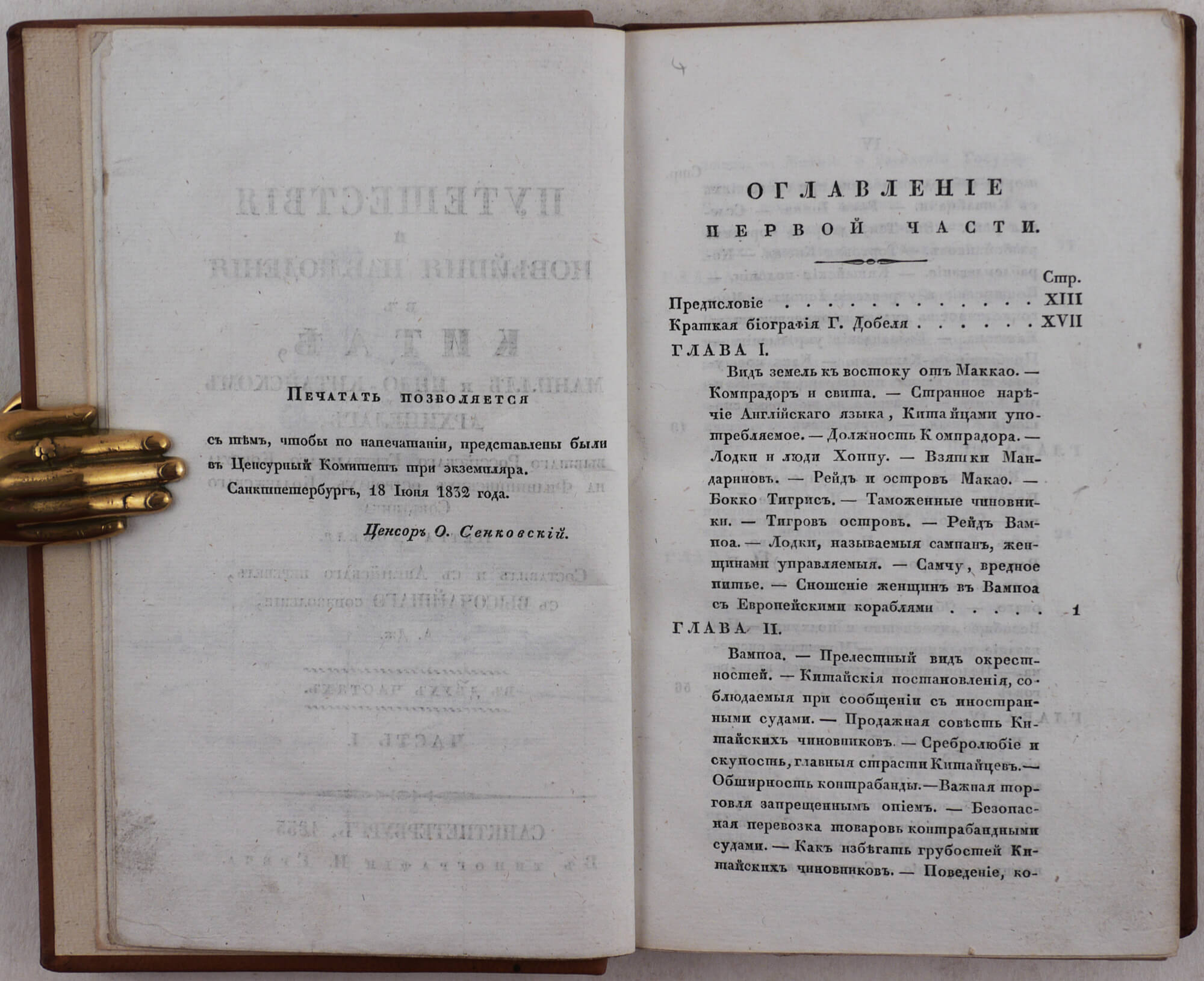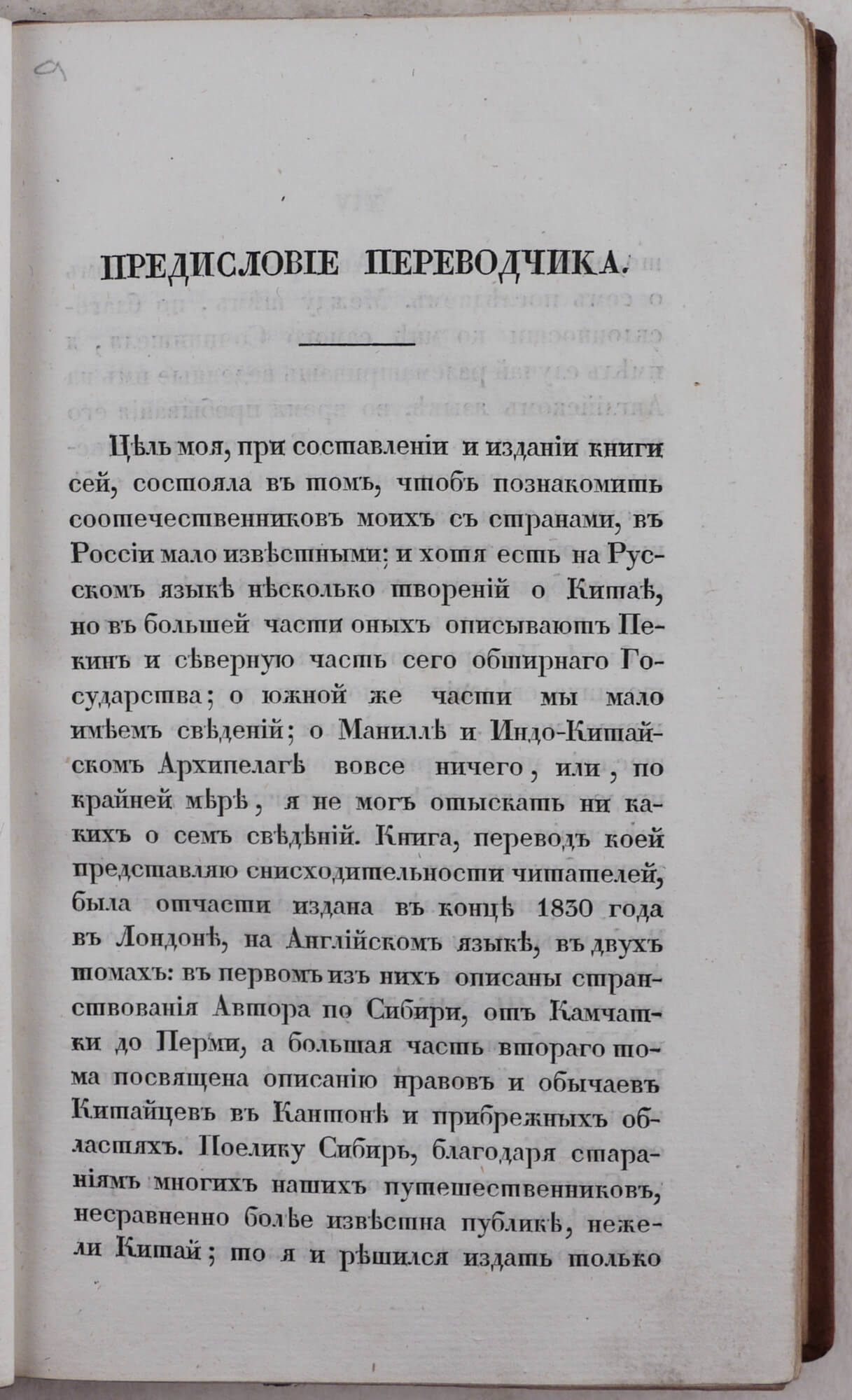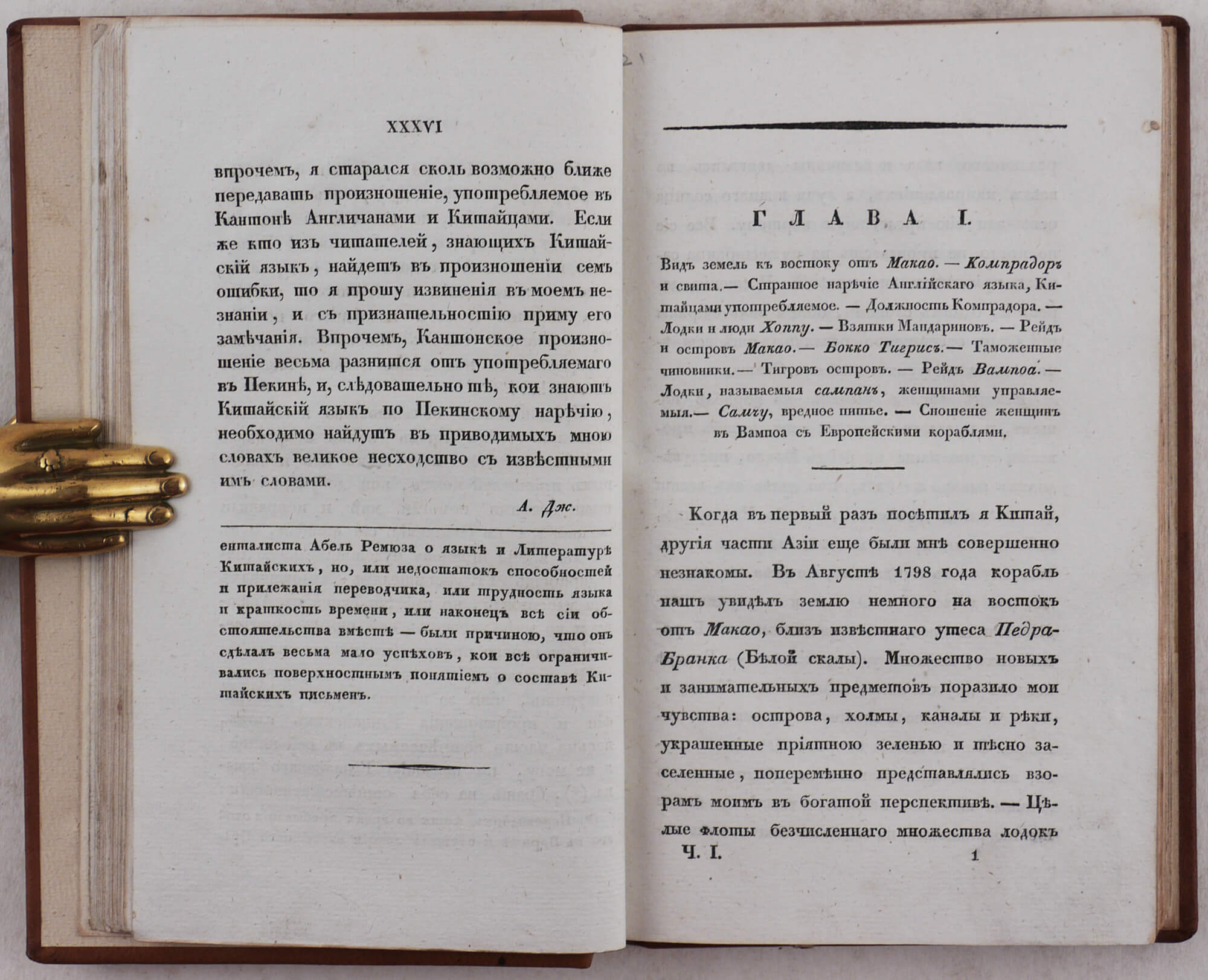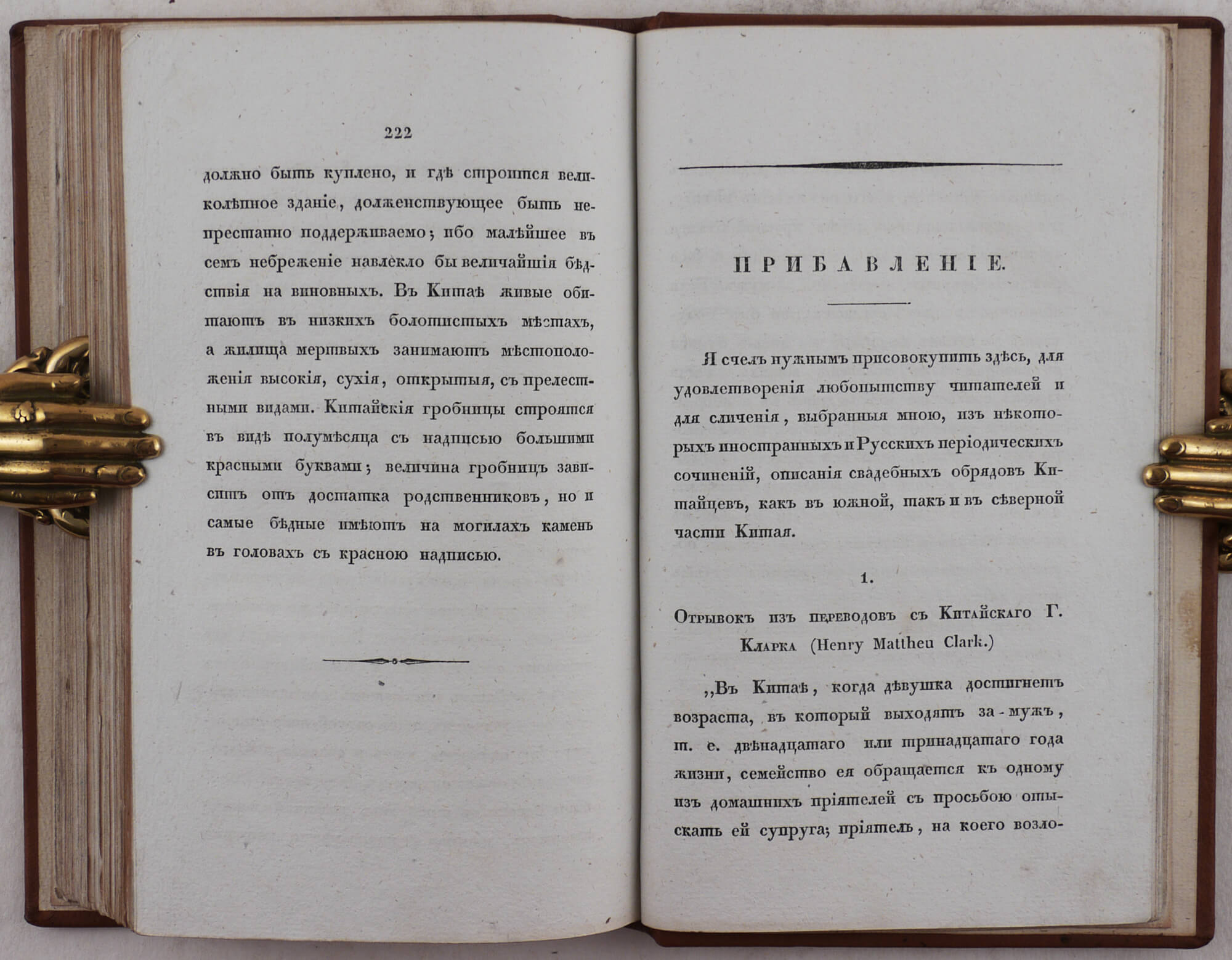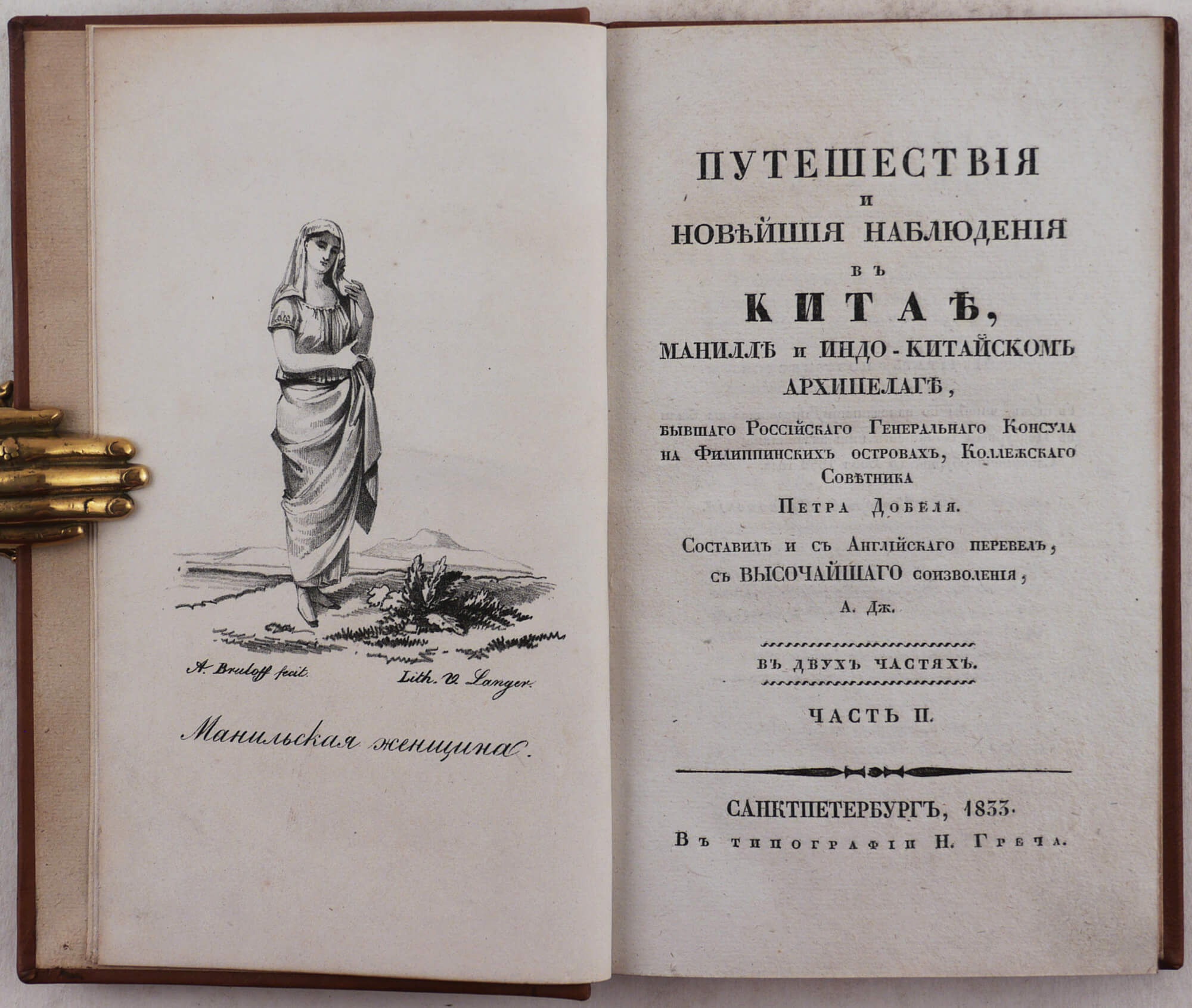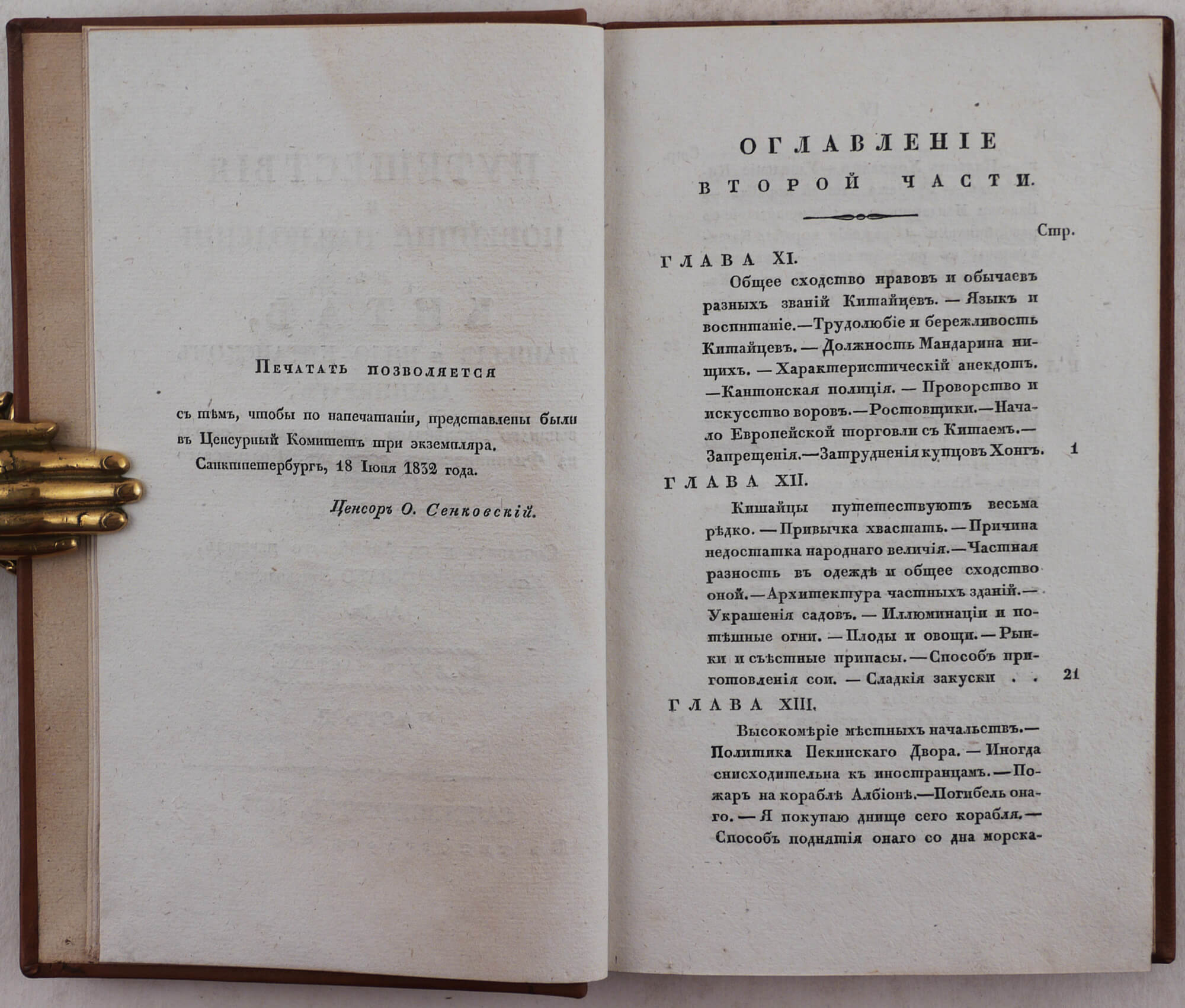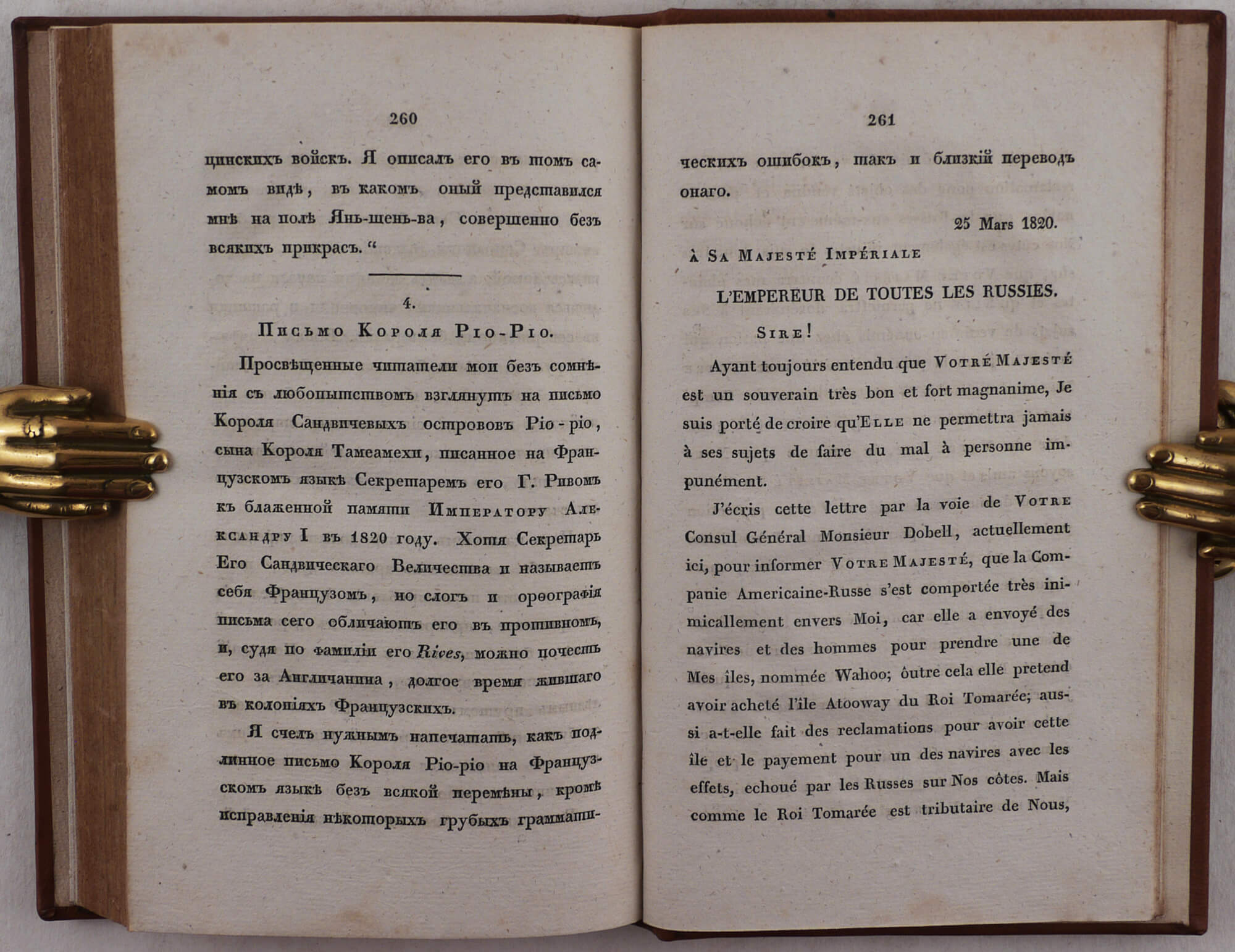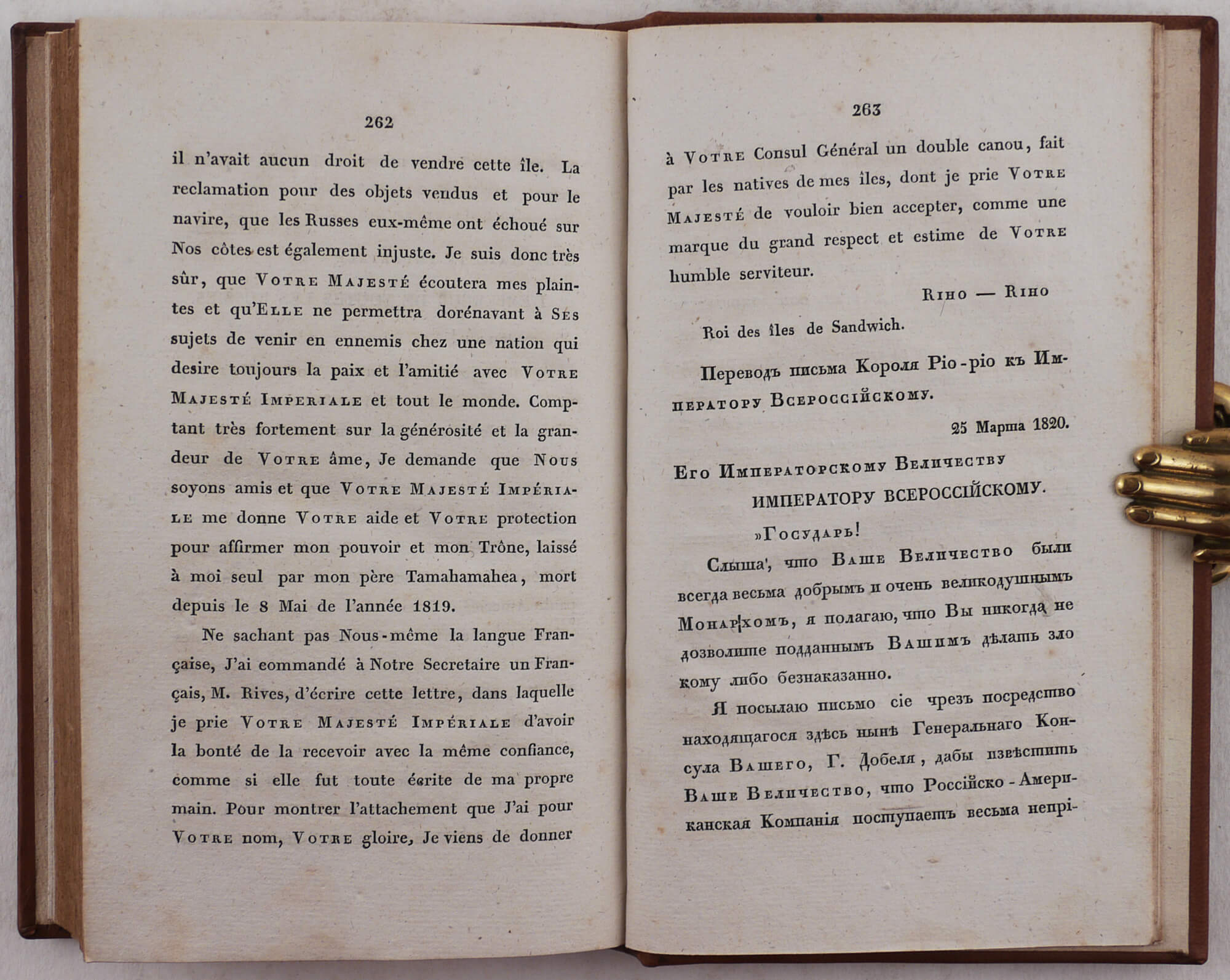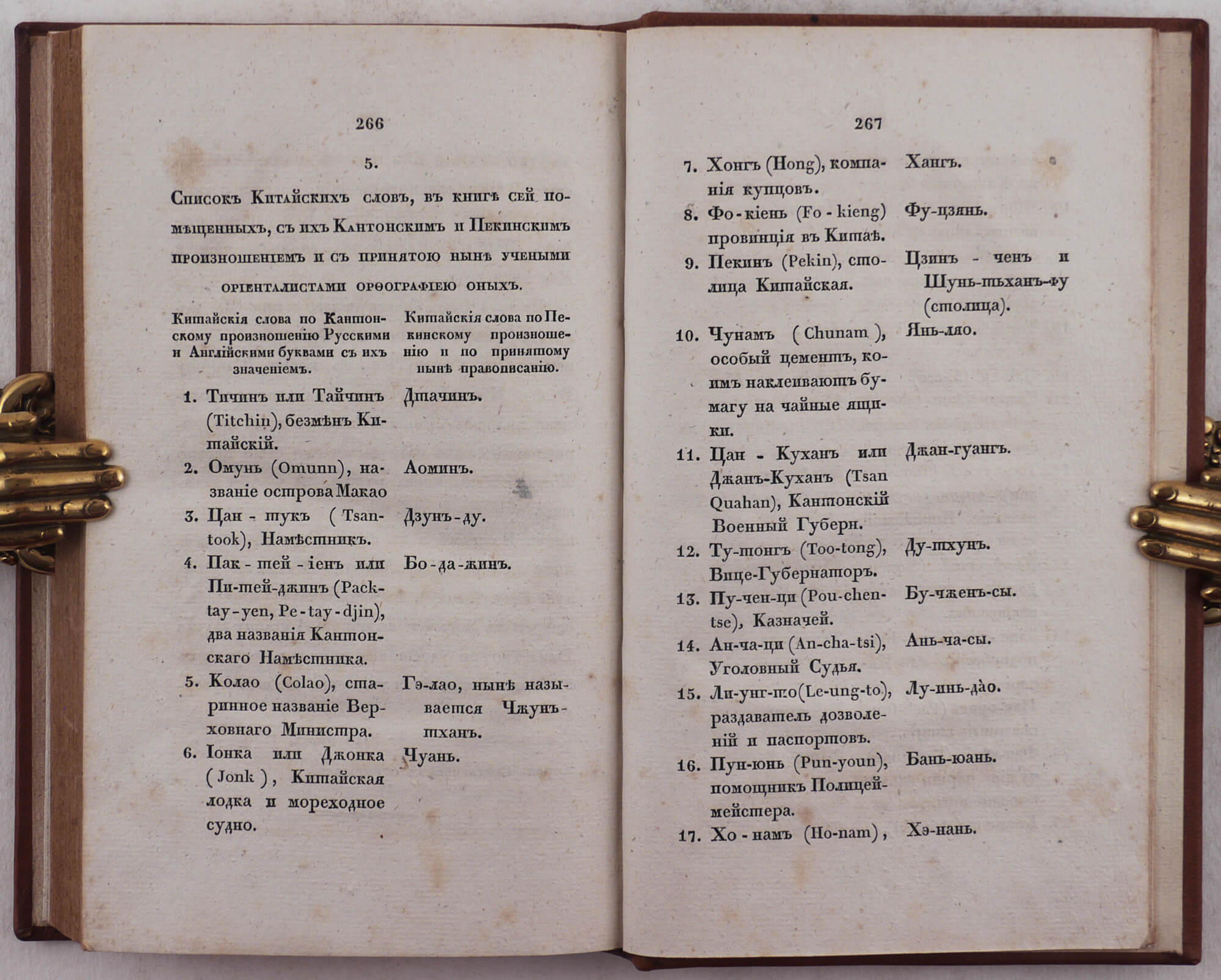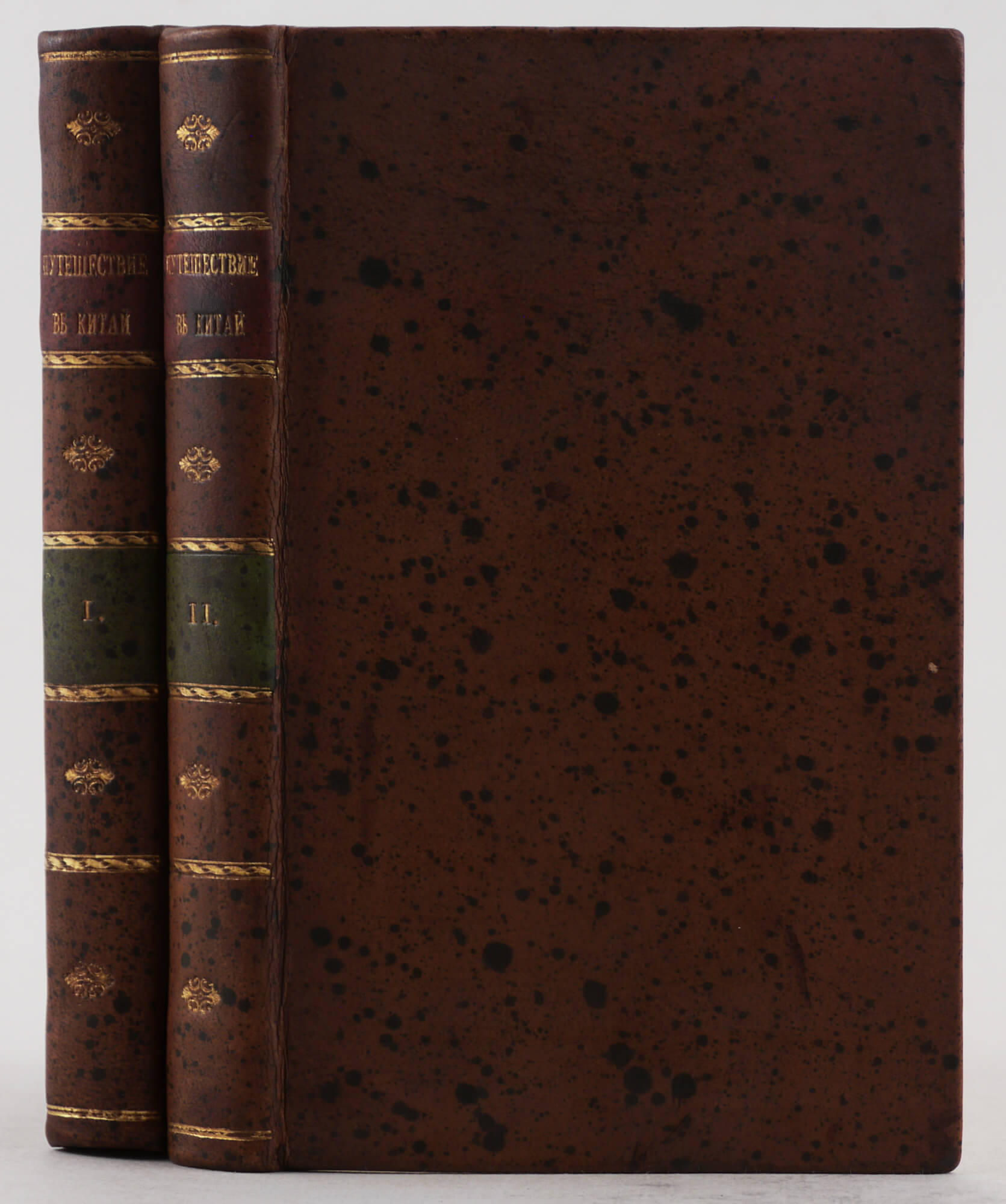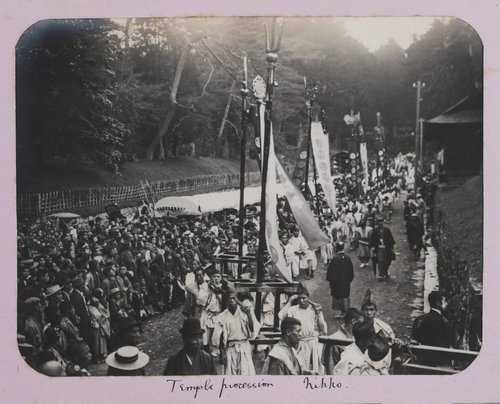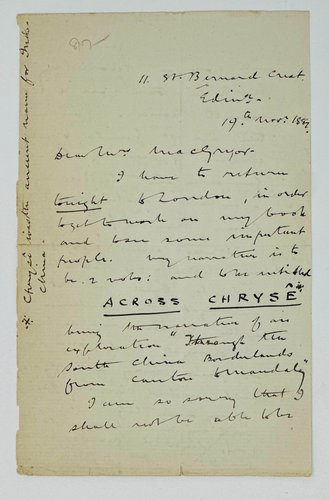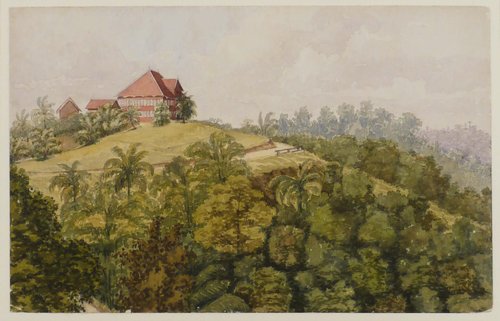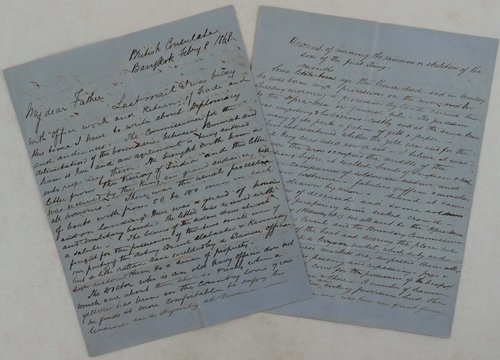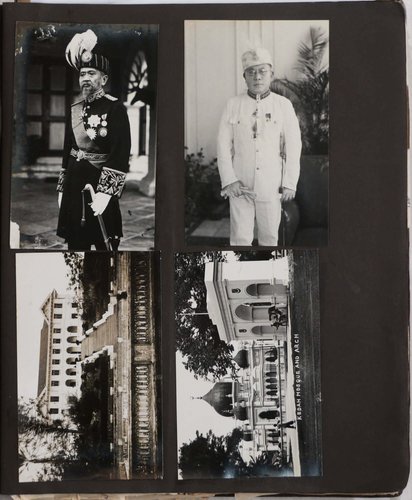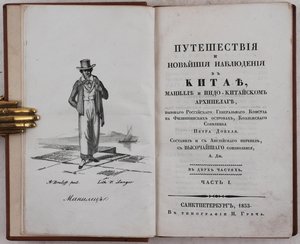
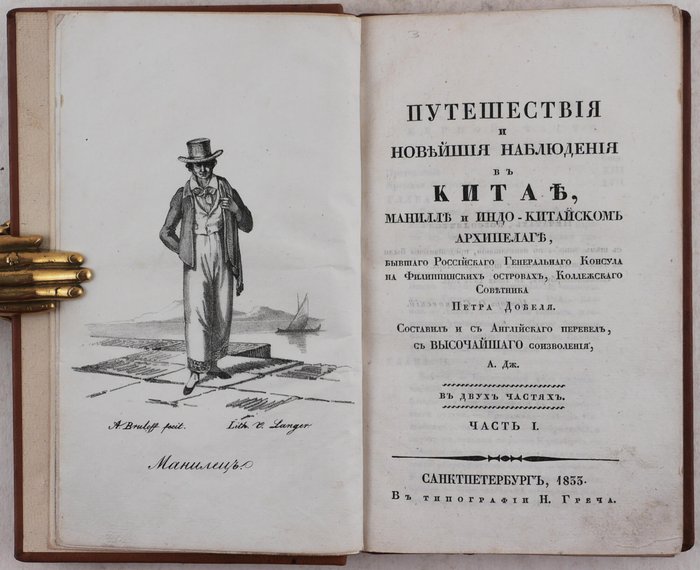
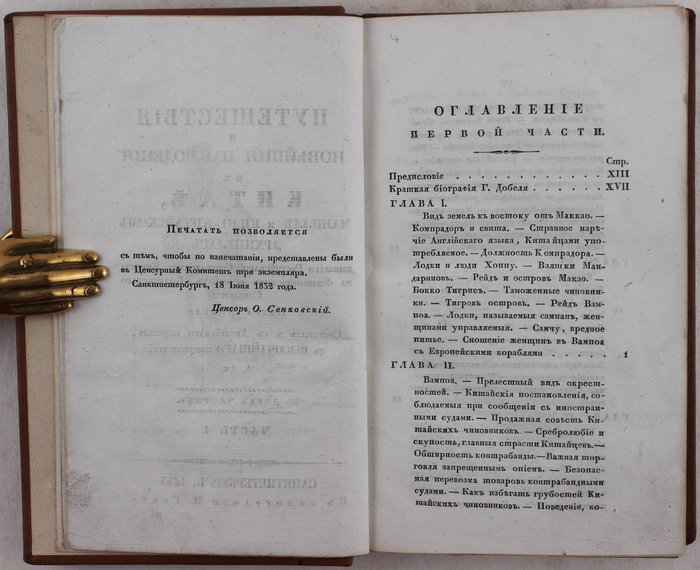
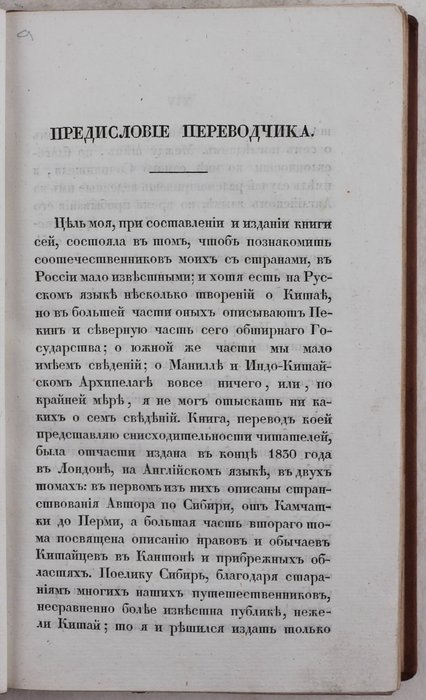
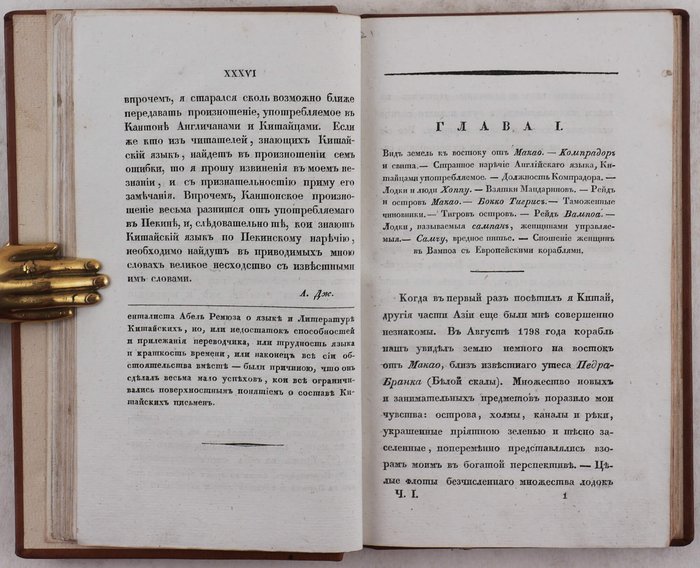
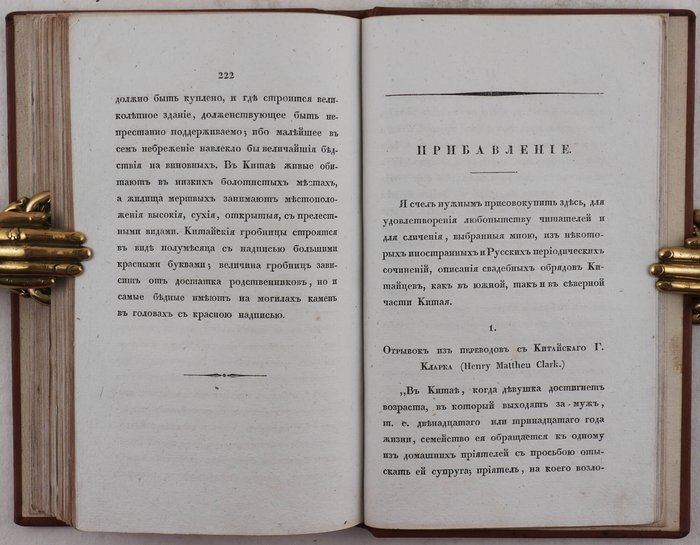
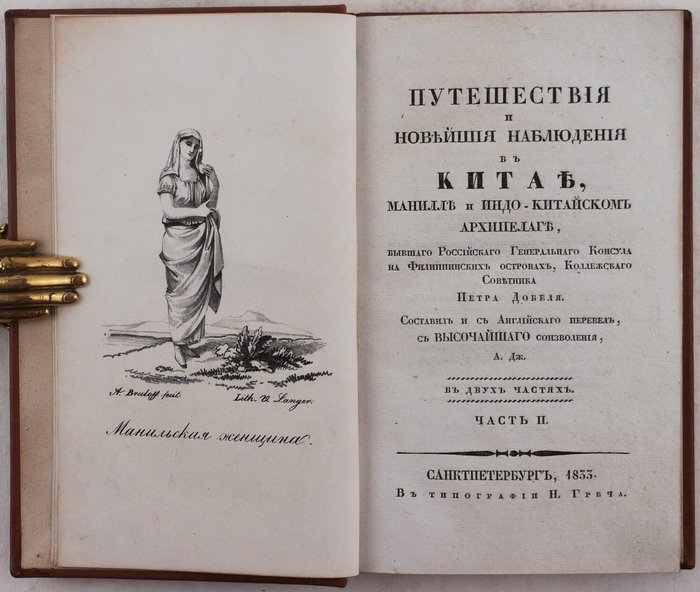
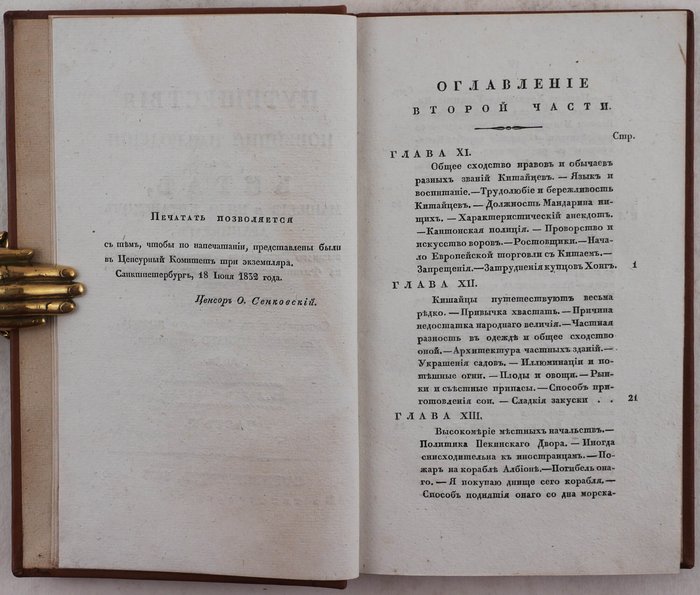
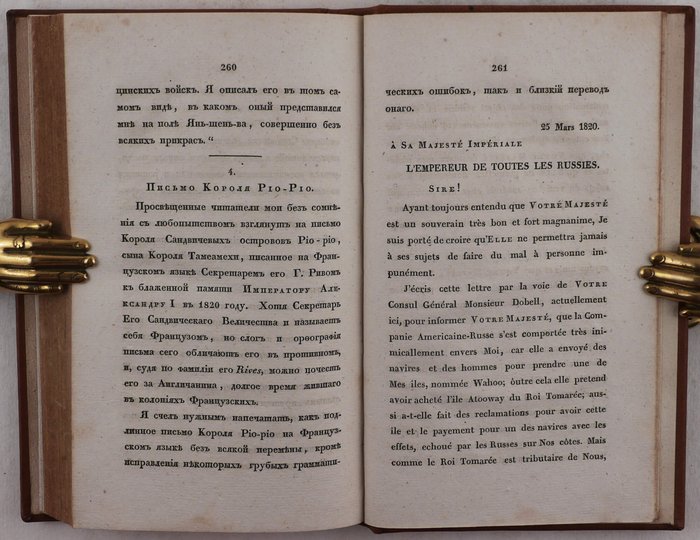
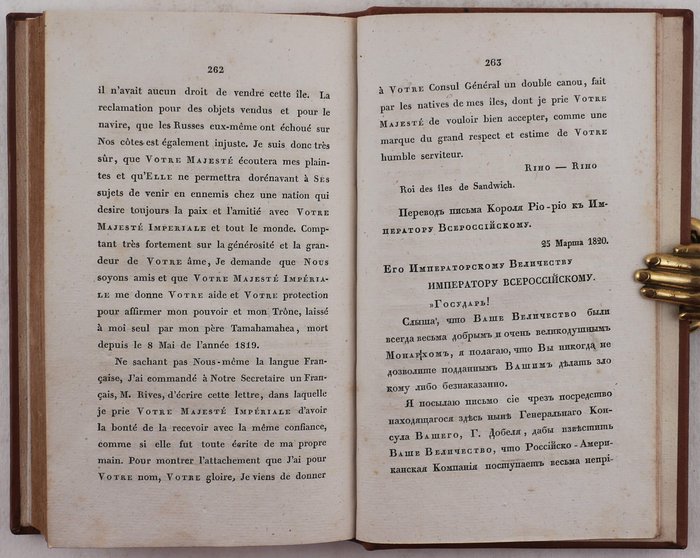
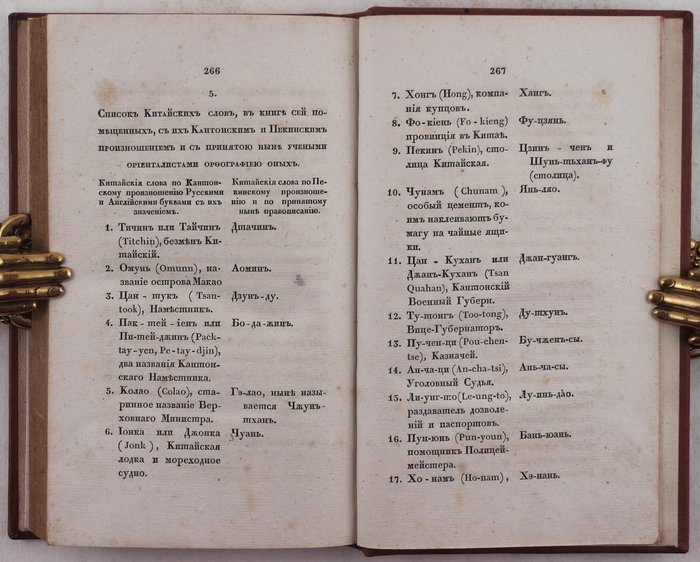
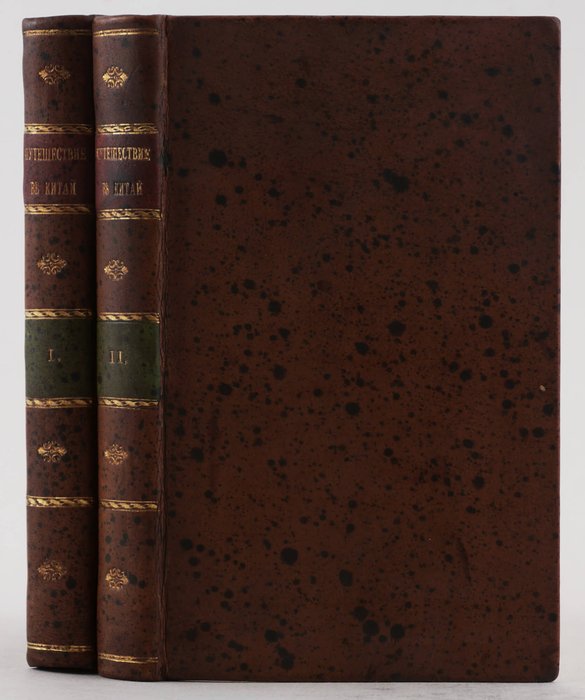
#R19
1833
Octavo, 2 vols. Xxxvi [i-ii - t.p., iii-vii – table of contents, ix-x - dedication to K. Bulgakov, xi-xii - second dedication, xiii-xxxvi – translator’s preface & Dobell’s biography], 237, [1 - errata]; [2 – t.p.], vii – table of contents, 272 pp. With two lithographed frontispieces (A. Bruloff fecit, Lith. V. Langer). Period style brown full sheep bindings housed in a brown cloth slipcase. Spines with gilt-tooled ornaments and gilt-lettered title labels; Occasional very mild foxing, a couple of pencil markings in text, but overall a very good set of this rare work.
First edition. Very rare Russian imprint with only six paper copies found in Worldcat. This is the first Russian edition, published three years after the first English edition ("Travels in Kamtchatka and Siberia," 2 vols., London, 1830). The Russian edition contains seven new chapters and seven supplements, not present in the English edition, with the important account of Dobell’s voyage to Hawaii and the audience with King “Riho-Riho” (Kamehameha II), the text of Kamehameha II’s 1820 letter to Russian Emperor Alexander I, Dobell’s first biography and original descriptions of the Philippines, Singapore, and the Malay Archipelago. The first French edition in one volume (Sept années en Chine… Paris, 1838) is a direct translation from the Russian edition done by Russian prince Emmanuel Mikhailovich Golitsin/Galitzine (1805-1853). It has no text difference with the Russian edition (apart from some changes in the order and structure of chapters xiii-xvii). Forbes was incorrect in his statement that “the author’s remarks on his voyage to Hawaii are not in this [Russian] edition” (Forbes 836). In fact, they are present in the Russian edition (pp. 111-129) and make it superior in significance to the French one.
The Russian edition contains thirteen chapters from the first English edition, dedicated to Dobell’s travels across China, the Philippines and South-East Asia in 1798-1828, with nice descriptions of Canton, Macao, Pearl River, Bocca Tigris, Whampoa (Pazhou) Island, Chinese manners and customs, etc. The whole part about “Travels in Kamtchatka” in 1813-1812 from the English edition (the entire first volume and the first four chapters of the second volume) is not included. As the Russian translator noted, “Since Siberia, thanks to endeavours of many of our travellers, is known to the public much better than China, I had the courage to publish only what the respected Author communicated to us about the latter…” (Preface, p. xiii-xiv).
Seven additional chapters (XIII, XIV, XV, XVII, XVIII, XIX, and XX) base on Dobell’s private diaries (Preface, p. xiv). They contain information about Dobell’s success in salvaging and selling the remnants of the ship “Albion” wrecked near Whampoa Island in 1807, the rescue of Boston ship “Atahualpa” from Chinese pirates or “Ladrones” in 1806, the rescue of Philadelphia ship “Asia” at the Bocca Tigris strait in 1807 (with an original article on ginseng written by the Russian translator), Admiral William’s Drury occupation of Macao during the Napoleonic Wars in 1808, etc. Two chapters (XVII and XVII) give one of the first overviews in the Russian language of the islands of South-East Asia and the Malay Peninsula. They contain stories about Borneo, Sumatra, Formosa (Taiwan), the Bugis Kingdom of Wajoq in south Sulawesi (mistakenly called a separate island), the foundation of Singapore, tin mining and trade, opium, Javanese coffee and the raise of its consumption, Chinese settlers, trade with Chinese and Europeans, prospects of potential advantages for Russia to start the trade with South-East Asia, etc. Two chapters describe Manila, the Luzon Island and the cholera riots in October 1820. The chapter about Dobell’s visit to Hawaii describes King Kamehameha II, retells the conversation between him and Dobell, and gives details of Dobell’s speech at the Hawaiian Chiefs' council, mentioning prime minister William Pitt Kalanimoku. There is also an account of the letter from Kamehameha II to Alexander I, talking about the issues with the Russian-American Company after Georg Schaeffer’s attempt to establish a Russian colony on Atuvai (Kauai) Island in 1815-1817.
The preface contains the first biography of Dobell, compiled by the translator and based on Dobell’s diaries and oral stories (Preface, p. xvi). The main text is accompanied by seven supplements, including articles from “some Russian and foreign periodicals,” the text of Kamehameha II’s letter to Alexander I and a concise dictionary of selected Chinese words and names. Two supplements to vol. 1 are dedicated to Chinese wedding customs: “An excerpt from the translations from Chinese by Mr. Henry Matthew Clark” (p. 223-228), “Customs at Chinese weddings in Peking” by “L-sky” [Russian sinologist Zakhar Fyodorovich Leontievsky] (pp. 228-237). Supplements to vol. 2: “About the Chinese migration [to Southeast and Southern India]” (pp. 222-233); “About Manila, [by a German traveller]” (pp. 233-248); “Chinese Army” (from Z. Leontievsky’s article in the “Severnaya Pchela” newspaper; pp. 248-260); “The Letter by King Rio-Rio” (pp. 260-265); “A list of Chinese words, used in this book, with their Canton and Peking pronunciation and with their modern orthography approved by Orientalists” (pp. 266-272).
An American of Irish origin, Peter Dobell (1775-1852) graduated from Philadelphia University and took part in the American War of Independence (1775-1783). In 1798 he went on a first trade voyage to Canton (Guangzhou) where he settled in 1803. Until 1828 he actively travelled along the coast of southern China and across South-East Asia, especially the Philippines. In 1805 Dobell helped Adam von Krusenstern, the leader of the first Russian circumnavigation (1803-1806), settling the trade affairs of the expedition with the Canton merchants, and received for this a diamond ring from the Russian Emperor Alexander I. Dobell actively promoted the idea of establishing trade between Russia and South-East Asia, seeing this as an opportunity of supplying cheap food and other goods to Russian settlements in Kamchatka, North Pacific and Alaska. In 1812 he brought the first cargo of salt and provisions to Kamchatka and then crossed Siberia to present his plan of the establishment of trade relations with the Philippines to the Russian government. In 1817 the Imperial decree founded the Russian General Consulate in Manila which became the first Russian diplomatic post in South-East Asia. Dobell took Russian citizenship and became the first Russian consul in the Philippines (he held the post until 1820). In 1819 Dobell proceeded to Kamchatka, planning to travel to Manila on frigate “Kamchatka” under the command of Vasily Golovnin. Since he missed Golovnin, who had left Petropavlovsk earlier, Dobell took command of his own brig, hired “7 or 8 sailors, half of which were the inhabitants of the Sandwich Islands, and two navigators” (Preface, p. xx) and travelled to Hawaii. He stayed there for two months and had an audience with King Kamehameha II and Hawaiian chiefs. The king presented Dobell with a letter to Emperor Alexander I. While in Manila, Dobell witnessed the cholera riots in October 1820; his house and library got pillaged. His attempts to establish a continuous trade between the Philippines and Kamchatka proved unsuccessful, and the Russian consulate in Manila officially closed in 1826. Throughout the 19th century, the duties of Russian consuls in the Philippines were carried out by local merchants of different nationalities. The first full-functioning consulate didn’t open before establishing diplomatic relations between the Soviet Union and the Philippines in 1976. Dobell returned to Saint Petersburg in 1828. Later he served as a Russian consul in Denmark.
The translator and compiler of the Russian edition Alexander Dzhunkovsky (1804-1850) who hid under the abbreviation “A. Dzh.,” was an Active State Councillor, censor, agronomist and secretary of the Russian Free Economic Society (Gennadi, G. Spravochny Slovar o Russkikh Pisateliakh i Uchenykh Umershikh v XVIII i XIX Stoletiyakh. Vol. 1. A-E. Berlin, 1876, p. 298). The two lithograph frontispieces portraying a man and a woman from Manila were executed after the original drawings of Alexander Brullov (1798-1877), prominent Russian artist and architect, professor of the Imperial Academy of Arts and the elder brother of the famous Russian painter Karl Brullov (1799-1852).
Dobell was "an Irish trader and adventurer, [who] had formerly been a merchant at Canton. In return for negotiating the safety of Krusenstern's ship, which in 1804 was on the point of being seized by the Chinese at Canton, Tsar Alexander rewarded Dobell with the position of Russian consul-general to the Pacific Ocean. The appointment forced him to quit Canton and forfeit his business. From his base at Manila in the Philippines, Dobell travelled widely in the Pacific, visiting the Sandwich Islands and the ports of Siberia" (Howgego 1800-1850, C39).
Cordier Sinica 2109; (Forbes 836 about the Russian edition and 1090 about the French edition); Howgego 1800-1850, C39; Hill 484 (about the English edition); Nerhood 155 (about the English edition).


